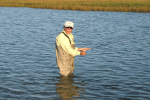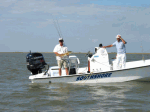written and photographed by Mary L. Peachin
Jun 2004, Vol. 8 No. 8
 Those purple-colored Bass Assassins and Texas Trout Killers weren’t quite living up to their deadly reputation. A glorious sunrise rose over the Gulf of Mexico as Burt Myers and I motored out of the small Matagorda City marina. We excitedly anticipated a great day of redfish and seatrout (weakfish).
Those purple-colored Bass Assassins and Texas Trout Killers weren’t quite living up to their deadly reputation. A glorious sunrise rose over the Gulf of Mexico as Burt Myers and I motored out of the small Matagorda City marina. We excitedly anticipated a great day of redfish and seatrout (weakfish).
Baitcasting with open bails, we tossed the locally popular “knock ’em dead” lures into the shallow muddy water of sizable 20-mile (by 4-mile wide) East Matagorda Bay. The leadheaded rubbery worm-like lures had an irresistible squiggly chartreuse flat tail with a cork bobber (to create more action on the retrieval) tied 16 inches above the tail. Today, those assassinators weren’t quite attracting the fish.
Guide Walt Schelle was “running the birds” by concentrating on finding seagulls “working the surface.” Seagulls feed on the shrimp that scramble from schools of trout and redfish. Working the birds was Walt’s GPS method of dead reckoning. During two days of fishing on both the east and west sides of the Bay, the 23-foot El Pescador tunnel boat, revved with a 150 HP Yamaha and TRP (twin rotating props) knotched 50-70 miles daily (as noted on his real GPS). 
Matagorda Bay is divided by the Colorado River, Texas’ longest river (more than 700-miles). The US Army Corps of Engineers built a lock system to spill river overflow, silt, logs, and other debris into the West Bay. This engineering feat was done to protect barges and pleasure boats from floating debris in the river along the intercoastal waterway, the watery route that extends from Brownsville, Texas through Florida then northward to Maine.
Birds take refuge on tree stumps spilled into the overflow. There appears to be a definite pecking order between the white pelicans and terns tightly perched wing to wing on numerous stumps lining a shoreline dense with wetland saltwater cane.
The Spanish translation of the word Matagorda is “dense canebrake” or “dense cane”. The Greater Egret and yellow-billed Oystercatcher fed along a marshy shore. We casted into a moderate wind with limited success using Bertram Curado bait reels on a 7-foot All Star Graphite PRL-SP rods. While we hooked into a flounder, several speckled trout, and small sand trout, on a better day we would have hooked the state limit in hours.
Matagorda’s fishing also extends 20 + miles offshore where snapper, dolphin, and kingfish can be plentiful.  The next day we idled through the locks into West Matagorda Bay. Sandhill cranes squawked, their huge wingspan flapping overhead while bottlenose dolphin finned through the water. In the distance we could see towering Texas oil rigs.
The next day we idled through the locks into West Matagorda Bay. Sandhill cranes squawked, their huge wingspan flapping overhead while bottlenose dolphin finned through the water. In the distance we could see towering Texas oil rigs.
Walt said after Burt caught a redfish, “it’s time to try for a Texas grand slam (a redfish, speckled trout, and flounder in one day of fishing). While the three of us caught and released more than a hundred fish the second day, we didn’t limit out on keepers. Burt had his redfish, but we didn’t hook into a flounder for the “slammer.” He also pulled in a Gafttopsail catfish releasing it carefully to avoid touching its three ominous stinging spines. Fortunately, a snagged “cabbage head or cannon ball” jellyfish fell off the hook boatside.
Local Jim Gann took fly fishers John Randolph and Ed Lawrence and myself wading in West Bay on our final day of the three-day fishing trip. Semi-retired, the former chemist and cattle rancher knows his fishing. Thousands of stingrays live on the sandy bottom, so we shuffled out feet hoping to avoid a painful stab from a spine in our leg. We didn’t have any stingray guards worn by many local waders. Numerous mounds of sharp-pointed oysters were hard on the feet. At the same time, these “oyster reefs” attract the redfish we were hoping to catch.
In the marsh along the shore, an Oystercatcher squealed like a newborn baby as I landed a black and white stripped drum, a cousin of the redfish. A small flock of roseate spoonbills flew out of the golden reeds. Catching the spooky good-eatin’ redfish just wasn’t in the cards for me.
Matagorda Bay is an easy saltwater fishing experience, especially for the “faint of stomach.” Burt Myers summed it up when he said “fishing Matagorda allows an angler steady action in a stable environment. Anglers can use simple tackle and catch a lot of fish.”  The place is relatively undiscovered. The Bay is a beautiful ecosystem, a fishers and birdlover’s paradise, but its tourism infrastructure is basic when it comes to accommodations and restaurants.
The place is relatively undiscovered. The Bay is a beautiful ecosystem, a fishers and birdlover’s paradise, but its tourism infrastructure is basic when it comes to accommodations and restaurants.
Located two hours south of Houston (80-miles), the county spreads between Bay City (the 20,000-pop. county seat), Palacios, and the smaller port of Matagorda City. The land is flat and expansive, its straight road lined with cattle ranches and rice fields. The South Texas Nuclear Plant is one of the areas primary industries. Matagorda is “where the Colorado (not the same as the river bordering western Arizona) meets the Gulf of Mexico.”
The county has a long settlement history beginning with the habitation of the Karankawas followed by the 17th century arrival of La Salle’s famed voyage. It was both a Spanish and Mexican colony. Some visitors come to Matagorda County simply to view more than 250 species of migratory, waterfowl and shore birds, or cruise the bay learning about the oysters and shrimpers. 
In Palacios, we joined locals for an outdoor all-you-can eat shrimp boil. Buckets of shrimp, sausage, and corn were set on the table. On the patio deck, Oysterman James Arnold, owner of sightseeing adventure Day On The Bay Services, shucked oysters just hauled from the bay. The shrimp were finger peeling good, the oysters deliciously slid down the throat. Several nights we dined on Tex-Mex food and, of course, we couldn’t spend four days in Texas without eating king-size beef in a steak house.
If you go: Kingfisher Guiding Service walt@matagordap-bay.com or 979-863-7666 Skipper’s Guide Service skipper@skppersguideservice.com or www.skippersguideservice.com Reel-Life Adventure Guide Jesse Arsola (flyfishing) Reel-life-adventures@orbitworld.net Texas’ daily fishing limits allow anglers to keep 10 speckled trout over 15 inches and 3 redfish or drums sized 20-28 inches. Larger redfish can be kept but must be tagged with a sticker on the angler’s license. A minimum 5-day license is required at a cost of $40 with a saltwater stamp.
